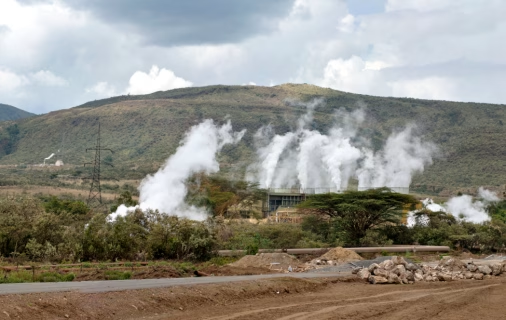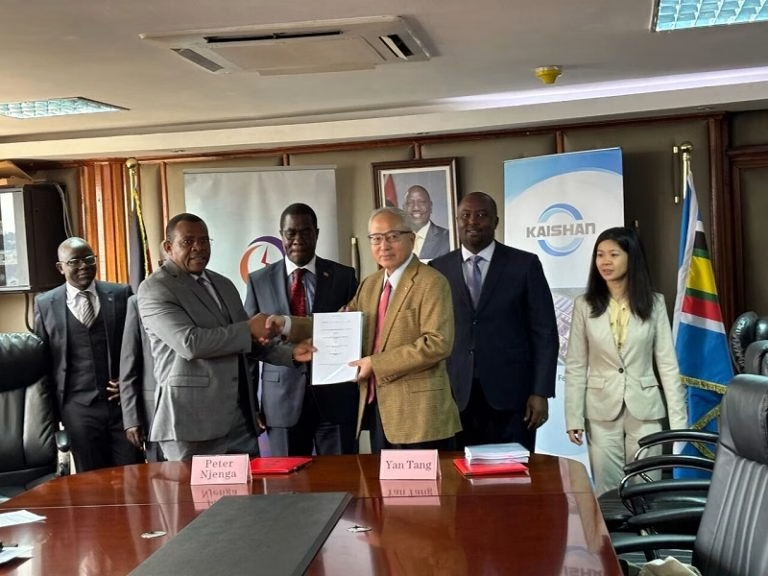Updated November 5, 2025- A groundbreaking ceremony was held for the geothermal-powered green fertilizer facility to be built by Kaishan in Naivasha, Kenya.
KenGen and China’s Kaishan Group have officially broken ground on the construction of a geothermal-powered green fertilizer production facility in Naivasha, Kenya. This comes after a geothermal steam supply agreement signed between the two sides a week ago.
The project aims to utilize geothermal steam to power the production of green ammonia and fertilizer. This serves the purpose of reducing carbon emissions while also reducing the dependence of the Eastern African region on imported fertilizers. According to the agreement that was signed, KenGen will supply steam from the Olkaria geothermal field to the 165-MW facility to be built. The facility will be run by Kaishan through local subsidiary Kaisan Terra Green Ammonia Limited. The contract period is outlined to be 30 years.
Additionally, the plant is expected to produce between 200,000 to 300,000 tonnes of green fertilizer every year. It is forecast to avoid more than 600,000 tonnes of carbon dioxide emissions per year. In contributing to Kenya’s economy, it will deliver approximately $13 million in annual net profits to KenGen.
Kaishan Group is emerging as a major developer in Kenya’s geothermal power sector. Other than this fertilizer project, Kaishan is also developing the OrPower 22 Geothermal Power Plant in Menengai.

Reported on October 29, 2025
Kaishan will be constructing a 165-MW geothermal-powered green ammonia facility in Kenya. The Kaishan Geothermal Green Ammonia and Green Fertilizer Project will be supplied by steam from the existing geothermal wells of KenGen.
The Chinese engineering company Kaishan Group Co. Ltd, through subsidiary Kaishan Terra Green Ammonia Limited, has inked a steam supply agreement with KenGen for a planned 165.4-MW geothermal power plant in Kenya. This facility is expected to produce 100,000 tons of green ammonia and green fertilizer annually. According to the terms provided by the agreement, Kaishan will be buildung the power plant. Also, the company will be receiving steam from KenGen’s operational geothermal fields.
Factsheet
Project name: Kaishan Geothermal Green Ammonia and Green Fertilizer Project
Developer/Operator: Kaishan Group Co., Ltd. (via subsidiary Kaishan Terra Green Ammonia Limited)
Location: Olkaria Geothermal Field, Kenya (utilizing KenGen steam)
Core technology: Utilizing geothermal power to produce green hydrogen via water electrolysis, which is then used to synthesize green ammonia and fertilizers.
Cost: Approximately $800 million
Geothermal power capacity planned: 165.4 MW (megawatts) power plant built and operated by Kaishan, using steam purchased from KenGen.
Annual production targets:
- Green Ammonia: 100,000 – 200,000 tons
- Green Urea (Fertilizer): 180,000 tons
- Calcium Ammonium Nitrate (Fertilizer): 300,000 tons
Annual revenue forecast: $220-250 million
Operating period: Expected to be more than 25 years.
Significance:
- World’s first large-scale geothermal hydrogen/ammonia production project.
- Africa’s first green fertilizer plant (once operational).
- Supports Africa’s green industrialization and promotes regional agricultural development.
Steam Supply Agreement
The steam supply agreement was signed at the Ministry of Energy of the Republic of Kenya. This agreement was signed in the presence of Dr. Tang Yan, Managing Director of Kaishan Group Co., and Eng. Peter Njenga, General Manager and CEO of KenGen.

Also, officials who were present at the signing ceremony was Minister of Energy of the Republic of Kenya, Hon. J. Opiyo Wandayi, EGH.
Project Cost
The project is expected to require an investment of about USD 800 million. Additionally, once it is completed and commences, the expected annual revenue will be $220-250 million. Additionally, the facility will use geothermal power to produce green ammonia, and subsequently, urea and calcium ammonium nitrate for fertilizers.
Also, the new project is part of Kaishan’s mission of becoming a “a major global player in green hydrogen and ammonia development and operations.” The company states that although there are numerous green ammonia production projects utilizing solar and wind power generation in the pipeline, few have actually been launched. This is because chemical production requires solar and wind power facilities to be augmented with energy storage. Both the technology and cost of energy storage remain bottlenecks for large-scale application.
Other Ammonia Production Projects Planned for Kenya
In another ammonia production projects in Kenya, Kaptagat solar plant is under development as part of a larger green ammonia project in the Rift Valley region of Kenya. Furthermore, the 195 megawatt (MW) photovoltaic (PV) solar park will power a plant that produces green hydrogen and ammonia for fertilizer.
The renewable ammonia will be used to meet regional demand for fertilizer, reducing the carbon footprint of production compared to conventional methods.

